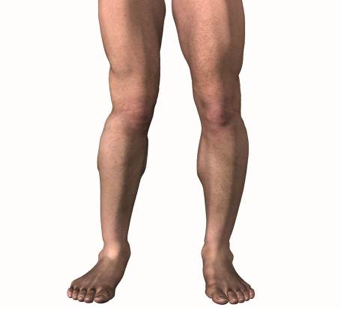Knee Pain and Foot Orthotics
 Sunday, April 1, 2012 at 3:05PM
Sunday, April 1, 2012 at 3:05PM Stuart Currie DC,
Director of Research, Sole Supports.
INTRODUCTION
There is an intuitive link in the kinetic chain between the foot and the knee, resulting in the common clinical practice of prescribing custom-made foot orthotics for patients with various types of knee pain.
Subjective knee pain is one thing that may prompt a clinician to think about foot orthotics in their treatment plan. There is an assumed relationship between feet and knees and a comprehensive knee evaluation considers both proximal and distal structures. What is relevant to the clinician is a determination of the root cause of the knee pain and whether foot pathology may be involved. While there are no hard and fast rules or substitute for a thorough history and physical exam, there are a few clues that can help determine the origin.
A Few Clinical Clues
The first case is asymmetric knee pain with asymmetric pronation. When the knee pain is on the same side as the pronated foot, there is reason to look at the ipsi-lateral foot as the cause. Figure 1 illustrates pronation of the right foot, subsequent internal rotation of the tibia and femur with the consequent alteration in knee orientation and function. Pronation can and should be evaluated both statically and dynamically. Tests such as the navicular drop test, and walking or treadmill gait analysis can help determine if knee pain is a result of altered foot posture. When evaluating the effects pronation has on the knee, be sure to observe the patella and its orientation relative to pronation that may or may not be happening concomitantly.
Bilateral knee pain with a bilateral valgus knee posture that is alleviated by active or assisted supination of the foot can also be an indicator that knee pain is related to foot posture. While often not a long term solution, taping the arch or a prefabricated insert is an inexpensive way to determine if changing foot function might have positive effects on knee pain.

Once an initial assessment has been made and a determination that a corrected foot posture is required to address the root cause of the knee pain, a custom orthotic can be a valuable tool. The effects of orthotics on the knee have been demonstrated with a kinematic and kinetic investigation revealing that molded orthotics reduced vertical loading rate and ankle inversion moment and increased maximum foot inversion and maximum knee external rotation moment (1).
Knee Pain and Foot Orthoses
Knee pain can be complex and the different causes of knee pain must be considered separately when considering an orthotic device. The response of knee pain to orthotic devices has been described as “individualistic” and “nonsystemic” (2) implying that care must be used in both patient and treatment selection.
With regards to knee osteoarthritis, there is some debate in the literature regarding the effectiveness of various devices. Traditionally, a laterally wedged insert has been used – theoretically offloading the medial compartment of the knee. A review of the literature on lateral wedges reveals positive, negative and equivocal results. With regards to a custom orthotic with full contact medial support, there is a theoretical basis for utilization. It has been shown that the plantar center of pressure (of the foot) in patients with medial knee OA has shown a high lateral loading component (3). In other words, people with symptomatic medial knee OA load the lateral aspect of their foot to a greater degree. Considering this information with investigations that have shown a medial shift of plantar pressure with a full contact, MASS position custom orthotic (4), there is a basis for controlling aberrant foot loading resulting in more optimal knee function in this patient population.
When comparing flat versus contoured foot orthoses, it has been shown that patients perceive more support through the heel and arch regions with a contoured support (2). In addition, subjects in the patellofemoral pain group reported a clinically significant reduction in knee pain as a result of wearing foot orthoses (2). Another study showed that custom made orthoses were an effective treatment to reduce the symptoms of patellofemoral pain (5)
The reasons for the improvements seen with a custom foot orthotic are more difficult to ascertain. Foot postural factors are thought to play a role. Kinetics and kinematics of the foot and lower limb (such as tibial internal rotation) may be involved. “Emerging evidence suggests that orthotics, specific shoe types and footwear interventions may provide an effective nonsurgical intervention in rheumatic diseases. Yet good data are sparse, and it is premature to recommend guidelines” (6).
The concept that foot mobility plays a role in the etiology of knee pain and the success of any treatment outcome has long been assumed. A recent study showed that foot mobility is related to knee pain outcomes; with results indicating that orthotics provide greater improvements in anterior knee pain than a wait-and-see approach and that individuals with greater mid-foot mobility are more likely to experience success from treatment (7). This underlines the importance of the evaluation of foot flexibility and mobility in the physical exam for prediction of treatment outcomes.
SUMMARY
In summary, while there is a need for further investigation into the mechanisms of knee pain as it relates to foot posture, there is evidence for the utilization of foot orthotics as one part of a comprehensive treatment plan.
References
1) Mundermann, A., (2003) Clin. Biomech. (Bristol., Avon.) 18, 254-262.
2) McPoil, T. G., (2011) J. Am. Podiatr. Med. Assoc. 101, 7-16.
3) Lidtke, R. H., (2010) J.Am. Podiatr. Med. Assoc. 100, 178-184..
4) Hodgon, B., (2006) Journal of Sport and Rehabilitation 15, 33-44.
5) Munuera, P. V., (2011) Prosthet. Orthot. Int. 35, 342-349.
6) Riskowski, J., (2011) Curr. Opin. Rheumatol. 23, 148-155.
7) Mills, K.,(2010).Br.J.Sports Med. 44, 1035-1046.
 CBP Seminars | Comments Off |
CBP Seminars | Comments Off |  Chiropractic,
Chiropractic,  knee pain,
knee pain,  sole supports
sole supports 

